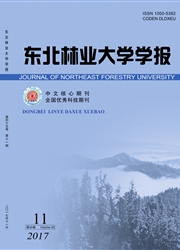

 中文摘要:
中文摘要:
利用PCR技术从柽柳cDNA文库中克隆出ThZFL目的基因序列,连接到pMD18-T载体,转化大肠杆菌DH5仪感受态,经检验后提取质粒,用BamHI和眈oRI限制性内切酶双酶切pMD18-T—ThZFL载体和pG-BKT7-BD空载体,并将酶切产物胶回收后,用T4DNA连接酶连接过夜后转化大肠杆菌DH5d感受态获得目的基因转化子pGBKT7-ThZFL,对转化子进行质粒PCR检验、质粒酶切检验、DNA测序鉴定。将测序检验正确的pG-BKT-/-ThZFL转化子,转化酵母Y2Hgold菌株,对转化后的酵母涂布SD/-Trp、SD/-Trp/X、DDO、TDO平板,验证目的基因的自激活作用,通过对酵母生长曲线的测量验证诱饵蛋白的毒性作用。试验结果表明:用于筛选与ThZ-FL表达蛋白相互作用的靶蛋白的酵母诱饵载体构建成功,重组诱饵载体pGBKT7-ThZFL对酵母自身没有毒害作用,可以继续进行下一步的文库筛选工作。
 英文摘要:
英文摘要:
The ThZFL gene was amplified by PCR from the Tamarix hispida cDNA library and inserted into pMD] 8-T vector, then transformed into E. coIi DH5ct to obtain the transformant. The pMD18-T-ThZFL and pGBKT7-BD were digested with BamH I and EcoR I, and resulting pGBKTT-ThZFL was transformed into E. coli DH5α. The positive clones were screened and identified by PCR, restriction endonuclease digestion and DNA sequence analysis. Then the positive recombinant plasmid pGBKT7-ThZFL was transformed into the competent yeast Y2Hgold strain and spread onto separate plates containing SD/-Trp, SD/-Trp/X, DDO and TDO. Results showed that no reporter genes were activated, and the bait vector was not toxic to Y2Hgold, suggesting the plasmid pGBKTT-ThZFL was constructed successfully, and could be used to screen target proteins interacting with the bait protein by the yeast two-hybrid system.
 同期刊论文项目
同期刊论文项目
 同项目期刊论文
同项目期刊论文
 期刊信息
期刊信息
